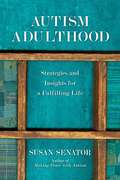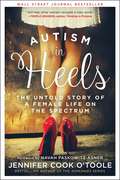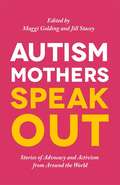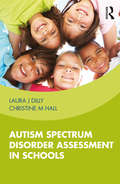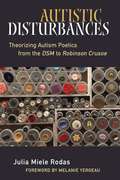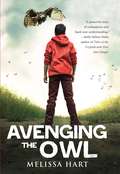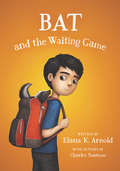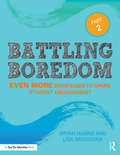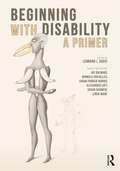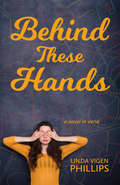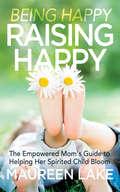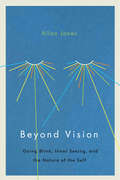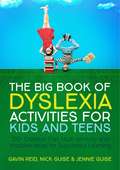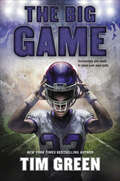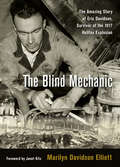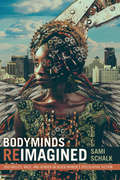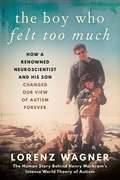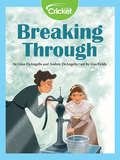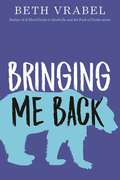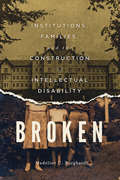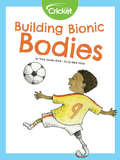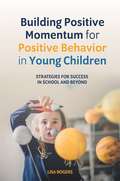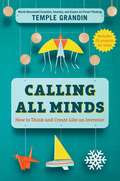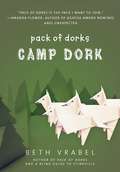- Table View
- List View
Autism Adulthood: Strategies and Insights for a Fulfilling Life
by John Elder Robison Susan SenatorOne of the biggest fears of parents with children with autism is looming adulthood and all that it entails. In her new book Susan Senator takes the mystery out of adult life on the autism spectrum and conveys the positive message that even though autism adulthood is complicated and challenging, there are many ways to make it manageable and enjoyable. From her own son with autism, now twenty-five, she has learned ?never say never.”Autism Adulthood features thirty interviews with autistic adults, their parents, caregivers, researchers, and professionals. Each vignette reveals firsthand a family’s challenge, their circumstances, their thought processes, and their unique solutions and plans of action. Sharing the wisdom that emerges from parents’ and self-advocates’ experiences, Senator adds her own observations and conclusions based on her long-term experience with autism. Told in Senator’s trademark warm, honest, and approachable style, Autism Adulthood paints a vivid and thought-provoking picture of many people grappling with grown-up, real-life autism. Senator’s is the only book of its kind, as real families share their stories and their creative solutions.
Autism in Heels: The Untold Story of a Female Life on the Spectrum
by Jennifer O'TooleThe face of autism is changing. And more often than we realize, that face is wearing lipstick.<p><p>Autism in Heels, an intimate memoir, reveals the woman inside one of autism’s most prominent figures, Jennifer O'Toole. <p><p>At the age of thirty-five, Jennifer was diagnosed with Asperger's syndrome, and for the first time in her life, things made sense. Now, Jennifer exposes the constant struggle between carefully crafted persona and authentic existence, editing the autism script with wit, candor, passion, and power. Her journey is one of reverse-self-discovery not only as an Aspie but--more importantly--as a thoroughly modern woman.<p><p>Beyond being a memoir, Autism in Heels is a love letter to all women. It’s a conversation starter. A game changer. And a firsthand account of what it is to walk in Jennifer's shoes (especially those iconic red stilettos).<p><p>Whether it's bad perms or body image, sexuality or self-esteem, Jennifer's is as much a human journey as one on the spectrum. Because autism "looks a bit different in pink," most girls and women who fit the profile are not identified, facing years of avoidable anxiety, eating disorders, volatile relationships, self-harm, and stunted independence. Jennifer has been there, too. Autism in Heels takes that message to the mainstream.From her own struggles and self-discovery, she has built an empire of empowerment, inspiring women the world over to realize they aren't mistakes. They are misunderstood miracles.
Autism Mothers Speak Out: Stories of Advocacy and Activism from Around the World
by Margaret Golding Jill Stacey Carole Kevan Edith Betty Morales Irene Anne Constantinou Isabel Bayonas Jackie Ceonzo Joan Curtis Liz Lawrence Mary Moeketsi Merry Barua Petra Dillmann Samira Al-Saad Shubhangi Vaidya Stephanie Lord Thando MakapelaRaising an autistic child comes with its own unique set of challenges, not least of which is dealing with the constant scrutiny of your parenting. This collection of stories from all corners of the globe celebrates the love, commitment and heroism of mothers of autistic people. These intimate accounts reveal both the differences in cultural attitudes, and the universality of the autism experience. Mothers from different cultural and socio-economic backgrounds speak out about the highs and lows of raising autistic children, and the shift in attitudes to autism as they watch their children enter adult life. Putting to bed the belief that autism is a result of poor parenting, this book not only lets parents know they are part of a supportive global community, it also highlights the positive aspects of autism and champions neurodiversity.
Autism Spectrum Disorder Assessment in Schools
by Laura Dilly Christine HallAutism Spectrum Disorder Assessment in Schools serves as a guide on how to assess children for autism spectrum disorders (ASD), specifically in school settings. Dilly and Hall offer a general overview of ASD, describe ASD assessment best practices, and explain the process of identifying ASD in schools. Current research and up-to-date science is incorporated in a practitioner-friendly manner, and short case vignettes will increase the accessibility of the book content and illustrate principles. As the rates of ASD reach 1/59 children, and school psychologists are increasingly expected to possess expertise in the assessment of ASD, this book serves as a must have for school psychologists, school social workers, and other practitioners.
Autistic Disturbances: Theorizing Autism Poetics from the DSM to Robinson Crusoe (Corporealities: Discourses Of Disability)
by Julia M RodasWhile research on autism has sometimes focused on special talents or abilities, autism is typically characterized as impoverished or defective when it comes to language. Autistic Disturbances reveals the ways interpreters have failed to register the real creative valence of autistic language and offers a theoretical framework for understanding the distinctive aesthetics of autistic rhetoric and semiotics. Reinterpreting characteristic autistic verbal practices such as repetition in the context of a more widely respected literary canon, Julia Miele Rodas argues that autistic language is actually an essential part of mainstream literary aesthetics, visible in poetry by Walt Whitman and Gertrude Stein, in novels by Charlotte Brontë and Daniel Defoe, in life writing by Andy Warhol, and even in writing by figures from popular culture. Autistic Disturbances pursues these resonances and explores the tensions of language and culture that lead to the classification of some verbal expression as disordered while other, similar expression enjoys prized status as literature. It identifies the most characteristic patterns of autistic expression-repetition, monologue, ejaculation, verbal ordering or list-making, and neologism-and adopts new language to describe and reimagine these categories in aesthetically productive terms. In so doing, the book seeks to redress the place of verbal autistic language, to argue for the value and complexity of autistic ways of speaking, and to invite recognition of an obscured tradition of literary autism at the very center of Anglo-American text culture.
Avenging the Owl
by Melissa HartA long time ago, in a galaxy far, far away, Han Solo avenged the destruction of an innocent planet by helping Luke Skywalker blow up the Death Star. Han walked away with a gold medal and the love of his life. But when Solo Hahn-named in honor of the beloved action hero-tries to avenge the death of his gray-and-white kitten, he gets eight months of community service. Eight months of working at the local raptor center helping owls-his now sworn enemies.For the first time in his life, Solo is labeled a troubled kid, an at-risk youth. He’d always gotten good grades, had good friends, and gotten along with his parents. He used to volunteer to read Reader’s Digest to old people at the retirement home next door, and his favorite thing in the whole wide world was to surf. He wrote screenplays for fun. But when his parents uproot him and move the family from California to backwoods Oregon, Solo starts to lose track of the person he was. Everything is upside down, and he finds himself dealing with things way beyond his understanding. He’s the new kid in town, and he’s got a bad reputation. The question is: What will he do next?This is a story about staying true to yourself when things get tough. Solo has every reason to lash out, but he ultimately needs to find a way to cope. Avenging the Owl deals with the difficult issues of suicide and depression, but more than anything it captures the powerlessness of being a kid. It won’t be easy, but the wild beauty of Oregon, its cold, empty beaches and captivating wildlife, may be just what Solo and his family need to help them start over.
Bat and the Waiting Game
by Charles Santoso Elana K. ArnoldIn the tradition of Clementine and Ramona Quimby, meet Bat. Author Elana K. Arnold returns with another irresistible story of friendship in this widely acclaimed series starring an unforgettable boy on the autism spectrum.For Bixby Alexander Tam (nicknamed Bat), life is pretty great. He’s the caretaker of the best baby skunk in the world—even Janie, his older sister, is warming up to Thor. When Janie gets a part in the school play and can’t watch Bat after school, it means some pretty big changes. Someone else has to take care of the skunk kit in the afternoons, Janie is having sleepovers with her new friends, and Bat wants everything to go back to normal.He just has to make it to the night of Janie’s performance. . . .
Battling Boredom, Part 2: Even More Strategies to Spark Student Engagement
by Bryan Harris Lisa BradshawDrive boredom out of your classroom—and keep it out—with the student engagement strategies in this book. In the first Battling Boredom, bestselling author Bryan Harris offered strategies on beginning a lesson, ending a lesson, small group work, and large group work. Now in Battling Boredom Part 2, Harris teams up with technology integration expert and former teacher Lisa Bradshaw to provide additional strategies on new topics such as academic talk, feedback, writing, classroom technology, and more. You’ll learn how to: Increase the quality and effectiveness of feedback to boost student performance. Engage students in meaningful reflection with writing prompts and exercises. Reenergize a lethargic class using movement-based activities. Integrate technology to create a more enriching classroom experience for students. Encourage students to speak up, share their ideas, and talk about their learning. With this toolbox of instructional strategies, you’ll have even more ways to end student boredom before it begins, resulting in class time that’s more efficient, more educational, and loads more fun!
Beginning With Disability: A Primer
by Lennard DavisWhile there are many introductions to disability and disability studies, most presume an advanced academic knowledge of a range of subjects. In Beginning with Disability, Lennard Davis has put together the first introductory reader for disability studies aimed at first- and second-year students in two- and four-year colleges. This volume of essays across disciplines including education, sociology, communications, psychology, social sciences, and humanities features accessible, readable, and relatively short articles that do not require specialized knowledge. Lennard Davis, along with a team of consulting editors, has put together feature a number of blogs, vlogs, and other videos to make the materials more direct and vivid to students. The text includes a section called "Subject to Debate" that features short pro and con pieces on controversial subjects that can be debated in class or act as prompts for assignments.
Behind These Hands
by Linda Vigen Phillips"A richly woven, unforgettable symphony of feelings and words" –Kirkus Reviews (Starred Review)Piano prodigy Claire Fairchild, 14, has always known music would be her life. So when she has the opportunity to enter a prestigious contest, she goes all in—until she realizes she’s also competing against Juan, a close childhood friend and one of the most talented musicians she knows. It doesn’t help that her thoughts about him are turning romantic.When Claire and her family receive a devastating blow from Batten disease, her world enters a tailspin. Claire decides her musical goals no longer seem relevant.She can’t reconcile the joy that music would bring to her life while her brothers succumb to an early and ugly death. Her decision puts everything at risk: her friendship with Juan, her parents’ expectations, and her own happiness.After Claire accompanies a friend on a school newspaper assignment, she meets a centenarian with a surprising musical past and only one regret in life. Claire knows something in her life has to change before it’s too late, but she’s not sure she has the courage to take the next step.
Being Happy, Raising Happy: The Empowered Mom's Guide to Helping Her Spirited Child Bloom
by Maureen LakeAn educator, holistic health coach and mother shares tips for self-care and mental wellness for mothers of strong-willed and highly-sensitive children. You Were Born Happy. You Were Born to Be Happy. You Were Born to Raise Happy. Being a mom is a lot of work. Being a mom of a spirited child can be exceptionally challenging. Moms who want to change their stress and anxiety levels and make a difference in the lives of their children and family need to take steps towards wellness. Maureen Lake teaches moms: · The reason why parenting a spirited child can cause more stress and anxiety than parenting kids who don&’t have the same challenges · The importance of cherishing yourself and setting clear boundaries so you can nurture your child · How to uncover the areas of your life that are causing the most stress and worry · How to regain footing by following a five-step process toward peace of mind · How to better manage family life with a nutrition plan to increase energy and other wellness tips that boost the immune system and create better overall health Being Happy, Raising Happy is for loving and caring moms who somehow forgot about their own desires and the impact they want to make in the world. This accessible guide will help women begin the journey towards revitalizing the mind, body, and spirit. &“Upon reading the first few pages, I was totally hooked. I felt like Maureen was sitting across the table teaching me the importance of taking care of myself and how my wellness will positively impact my child.&” —Gretchen Burman, author of The Adventures of Ooga and Zeeta
Benji the Bad Day and Me
by Sally J. PlaNothing seems to be going right for Sammy today. At school, he got in trouble for kicking a fence, then the cafeteria ran out of pizza for lunch. After he walks home in the pouring rain, he finds his autistic little brother Benji is having a bad day too. On days like this, Benji has a special play-box where he goes to feel cozy and safe. Sammy doesn't have a special place, and he's convinced no one cares how he feels or even notices him. But somebody is noticing, and may just have an idea on how to help Sammy feel better.
Beyond Vision: Going Blind, Inner Seeing, and the Nature of the Self
by Allan JonesIn this unique and exhilarating autobiography, Allan Jones – Canada’s first blind diplomat – vividly describes how an untreatable eye disease slowly decimated his visual world, most challengingly during his postings in Tokyo and New Delhi, and how he discovered and took to heart the revelatory Indian philosophy that changed his life. Advaita Vedanta, the most iconoclastic and liberating of the classical Indian philosophies, profoundly altered the author’s experience of self and world. He found that the true self, as distinct from the individual ego, far exceeds the boundaries of individuality. It lies beneath sightedness or blindness and is absolutely unaffected by the latter. This welcome shift of perspective was reinforced by startling discoveries in contemporary physics, evolutionary biology, and developmental psychology that are fully consistent with Advaitic metaphysics. As for the practical applications of metaphysics, this book demonstrates step by step how Advaitic insight and practice significantly reduce physical and psychological tension. The most telling examples have to do with adjustments compelled by extreme circumstances. Thus Jones describes how he drew upon Advaitic mindfulness techniques to maintain his white cane mobility skills in the teeth of permanent spinal, nerve, and muscle pain. The arc of Beyond Vision moves from the claustrophobically personal to the openness of the transpersonal. It begins in a dysfunctional family background, breaking out into a full life encompassing an adventurous foreign service career, spiritual exploration, and an unconventional kind of marital love.
The Big Book of Dyslexia Activities for Kids and Teens: 100+ Creative, Fun, Multi-sensory and Inclusive Ideas for Successful Learning
by Gavin Reid Nick Guise Jennie GuisePacked with fun, creative and multi-sensory activities, this resource will help children and teenagers with dyslexia become successful learners across the curriculum.The authors provide over one hundred tried-and-tested fun and imaginative activities and ideas to unlock the learning of children and teenagers with dyslexia in creative ways. The book is split into parts addressing literacy, numeracy, learning and cross curricular subjects. With fun activities like 'Spelling Ping-Pong' and 'Class Got Talent', it focuses on key skills such as listening, memory, spelling, writing and key board skills.Each activity includes a 'red herring' that will keep dyslexic children and teenagers entertained, extending them in interesting ways that will appeal to those who think outside of the box. Brimming with imaginative ideas, The Big Book of Dyslexia Activities is an essential toolkit for any teacher or parent working with children and young people with dyslexia.
The Big Game
by Tim GreenNew York Times bestselling author and former NFL defensive end Tim Green encourages readers to fight for their dreams in this heartfelt story about a young football star grappling with the stress of living up to his father’s name. Perfect for fans of Mike Lupica! <P><P>Danny Owens is dedicating his seventh-grade season to his Super Bowl champion father, who recently passed away. Danny promises everyone that, just like his dad, he’ll dominate the big game at the end of the season and earn a spot on the high school varsity team. <P><P>Then his English teacher catches him cheating on a test. Even though Danny can retake it, he knows there’s no point. He can’t read. And if Danny can’t pass this class, he won’t be eligible to play in the championship game that could unlock his future. <P><P>While his resentment rises against the only person willing to help him win off the field, the pressure to succeed begins to weigh heavily on Danny’s shoulders. Danny is being tested on every level now, and to pass, he may very well have to choose a different path from his father’s.
The Blind Mechanic: The Amazing Story of Eric Davidson, Survivor of the 1917 Halifax Explosion
by Marilyn Davidson ElliotA daughter’s inspiring biography of her father, who lost his sight in a massive maritime disaster—and went on to build a rewarding life and career.Eric Davidson was a beautiful, fair-haired toddler when the historic Halifax Explosion struck, devastating the Nova Scotia capital and killing almost two thousand people while seriously injuring thousands more. Eric lost both eyes—a tragedy that his mother never fully recovered from. Eric, however, was positive and energetic. He also developed a fascination with cars and how they worked—and he later decided, against all likelihood, to become a mechanic. Assisted by his brothers, who read to him from manuals, he worked hard, passed examinations, and carved out a decades-long career. This is the true story of his remarkable life and relentless determination, as told by his daughter.
Bodyminds Reimagined: (Dis)ability, Race, and Gender in Black Women's Speculative Fiction
by Sami SchalkIn Bodyminds Reimagined Sami Schalk traces how black women's speculative fiction complicates the understanding of bodyminds—the intertwinement of the mental and the physical—in the context of race, gender, and (dis)ability. Bridging black feminist theory with disability studies, Schalk demonstrates that this genre's political potential lies in the authors' creation of bodyminds that transcend reality's limitations. She reads (dis)ability in neo-slave narratives by Octavia Butler (Kindred) and Phyllis Alesia Perry (Stigmata) not only as representing the literal injuries suffered under slavery, but also as a metaphor for the legacy of racial violence. The fantasy worlds in works by N. K. Jemisin, Shawntelle Madison, and Nalo Hopkinson—where werewolves have obsessive-compulsive-disorder and blind demons can see magic—destabilize social categories and definitions of the human, calling into question the very nature of identity. In these texts, as well as in Butler’s Parable series, able-mindedness and able-bodiedness are socially constructed and upheld through racial and gendered norms. Outlining (dis)ability's centrality to speculative fiction, Schalk shows how these works open new social possibilities while changing conceptualizations of identity and oppression through nonrealist contexts.
The Boy Who Felt Too Much: How a Renowned Neuroscientist and His Son Changed Our View of Autism Forever
by Lorenz WagnerAn International Bestseller, the Story behind Henry Markram&’s Breakthrough Theory about Autism, and How a Family&’s Unconditional Love Led to a Scientific Paradigm Shift Henry Markram is the Elon Musk of neuroscience, the man behind the billion-dollar Blue Brain Project to build a supercomputer model of the brain. He has set the goal of decoding all disturbances of the mind within a generation. This quest is personal for him. The driving force behind his grand ambition has been his son Kai, who has autism. Raising Kai made Henry Markram question all that he thought he knew about neuroscience, and then inspired his groundbreaking research that would upend the conventional wisdom about autism, expressed in his now-famous theory of Intense World Syndrome. When Kai was first diagnosed, his father consulted studies and experts. He knew as much about the human brain as almost anyone but still felt as helpless as any parent confronted with this condition in his child. What&’s more, the scientific consensus that autism was a deficit of empathy didn&’t mesh with Markram&’s experience of his son. He became convinced that the disorder, which has seen a 657 percent increase in diagnoses over the past decade, was fundamentally misunderstood. Bringing his world-class research to bear on the problem, he devised a radical new theory of the disorder: People like Kai don&’t feel too little; they feel too much. Their senses are too delicate for this world.
Breaking Through
by Gina DeAngelisWhen she was young, Helen Keller suffered a fever that cost her her sight and hearing. For a time, her parents let her run wild, but eventually, they hired Anne Sullivan to teach Helen. The two worked together for many years.
Bringing Me Back
by Beth VrabelNoah is not having a good year. His mom is in prison, he's living with his mom's boyfriend—who he's sure is just waiting until his mother's six month sentence is up to kick him out—and he's officially hated by everyone at his middle school, including his former best friend. It's Noah's fault that the entire football program got shut down after last year. One day, Noah notices a young bear at the edge of the woods with her head stuck in a bucket. A bucket that was almost certainly left outside as part of a school fundraiser to bring back the football team. As days go by, the bear is still stuck—she's wasting away and clearly getting weaker, even as she runs from anyone who tries to help. And she's always alone. Though Noah ignores the taunts at school and ignores his mother's phone calls from jail, he can't ignore the bear. Everyone else has written the bear off as a lost cause—just like they have with Noah. He makes it his mission to help her. But rescuing the bear means tackling his past—and present—head-on. Could saving the bear ultimately save Noah, too?
Broken: Institutions, Families, and the Construction of Intellectual Disability (McGill-Queen's/Associated Medical Services Studies in the History of Medicine, Health, and Society #50)
by Madeline C. BurghardtAfter 133 years of operation, the 2009 closure of Ontario's government-run institutions for people with intellectual disabilities has allowed accounts of those affected to emerge. Madeline Burghardt draws from narratives of institutional survivors, their siblings, and their parents to examine the far-reaching consequences of institutionalization due to intellectual difference. Beginning with a thorough history of the rise of institutions as a system to manage difference, Broken provides an overview of the development of institutions in Ontario and examines the socio-political conditions leading to families' decisions to institutionalize their children. Through this exploration, other themes emerge, including the historical and arbitrary construction of intellectual disability and the resulting segregation of those considered a threat to the well-being of the family and society; the overlap between institutionalization and the workings of capitalism; and contemporaneous practices of segregation in Canadian history, such as Indian residential schools. Drawing from people's direct, lived experiences, the second half of the book gathers poignant accounts of institutionalization's cascading effects on family relationships and understandings of disability, ranging from stories of personal loss and confusion to family breakage. Adding to a growing body of work addressing Canada's treatment of historically marginalized peoples, Broken exposes the consequences of policy based on socio-political constructions of disability and difference, and of the fundamentally unjust premise of institutionalization.
Building Bionic Bodies
by Tracy Vonder Brink Mark HicksDo you know someone who has a prosthetic? Many people that you might see have prosthetics and you cannot even tell! In fact, people have created and used prosthetics for thousands of years! This story shows how prosthetics have changed over time in the way they have been created and allowed mobility. You will also learn how technology has allowed prosthetics to help even more people in ways than they ever have before. Prosthetics help people to walk and run, hear, eat, and to even help them stay alive! Some may say that important pieces of technology have allowed people to become "bionic!"
Building Positive Momentum for Positive Behavior in Young Children: Strategies for Success in School and Beyond
by Lisa RogersProviding practical solutions to common behavioral problems, this book shows how to use the positive momentum approach to encourage long-term positive behaviour among children aged 3-9. Covering issues such as what to do when a child avoids doing work, when they engage in rough play, and when they won't stay in their seat, this book includes targeted behavioral strategies that start with the underlying foundations of behaviour and result in lasting positive change. Through real life examples, the book shows how educators can be role models for children, and how school staff can collaborate with families for success beyond the classroom. The book also includes information specific to working with children with special needs. Accompanying behaviour charts and goal mapping resources are available to download to help with tracking a child's progress.
Calling All Minds: How To Think and Create Like an Inventor
by Temple GrandinFrom world-renowned autism spokesperson, scientist, and inventor Temple Grandin -- a book of personal stories, inventions, and facts that will blow young inventors' minds and make them soar.Have you ever wondered what makes a kite fly or a boat float? Have you ever thought about why snowflakes are symmetrical, or why golf balls have dimples? Have you ever tried to make a kaleidoscope or build a pair of stilts? <p><p>In Calling All Minds, Temple Grandin explores the ideas behind all of those questions and more. She delves into the science behind inventions, the steps various people took to create and improve upon ideas as they evolved, and the ways in which young inventors can continue to think about and understand what it means to tinker, to fiddle, and to innovate. And laced throughout it all, Temple gives us glimpses into her own childhood tinkering, building, and inventing. <p>More than a blueprint for how to build things, in Calling All Minds Temple Grandin creates a blueprint for different ways to look at the world. And more than a call to action, she gives a call to imagination, and shows readers that there is truly no single way to approach any given problem--but that an open and inquisitive mind is always key. <P><b>A New York Times Bestseller</b>
Camp Dork (Pack of Dorks #2)
by Beth VrabelThe pack of dorks heads to camp—and this time the bully they face might just be one of their own.Sheldon convinces Lucy, Sam, April, and Amanda to join him at Camp Paleo. Like cavemen, the campers are going to have to make do without air conditioning, and they'll dig for fossils during the day. And Grandma's coming too—as the lunch lady for the camp next door. But Sam backs out at the last minute to attend a gymnastics camp instead. Lucy wonders why she misses him so much—it's not like he's her boyfriend. Why does the word "boyfriend" make her blush? She needs a distraction. Enter Mr. Bosserman, the grouchy camp leader who won't budge on the camp's caveman theme. The old man needs some softening up, and Lucy knows just the person for the job: Grandma. One successful match made, Lucy starts to see potential lovebirds everywhere. But when the wrong campers pair up, the pack falls apart, all under the watchful eye of a secret blogger who's been writing about the camp's activities. Even worse? A thief is targeting everyone but Lucy, setting her up to look guilty. Soon Lucy finds herself alone, left to fix the messes she's made. If she fails, the pack may be splintered for good.
